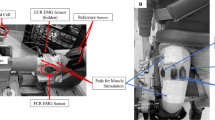Abstract
In the motor system, one specific movement is generated, and, simultaneously, other possible movements are suppressed; a process called surround inhibition. Focal hand dystonia (FHD) is a movement disorder characterized by a loss of surround inhibition. In order to explain the deficit in surround inhibition induced by volitional movement in FHD patients, we examined the inhibitory circuit activated by afferent stimulation at “long latency”. We studied 14 patients (age 48.9 ± 13.2 years, 3 females, 11 males) with idiopathic task-related FHD. To measure long-latency afferent inhibition (LAI), transcranial magnetic stimulation (TMS) was applied to the affected hemisphere for FHD patients and to the dominant hemisphere for 17 healthy volunteers. Motor evoked potentials (MEPs) were recorded over abductor digiti minimi (ADM) and first dorsal interosseous (FDI) during rest and during voluntary phasic flexion of the second digit. Subjects were given electrical stimulation to either their fifth digit (homotopic to ADM, heterotopic to FDI) or their second digit (heterotopic to FDI, homotopic to ADM) at twice sensory perceptual threshold 180 ms prior to TMS application. Additionally, F-waves were recorded from ADM. At rest, we found a significant decrease in ADM MEP amplitudes with both homotopic and heterotopic stimulation compared to the corresponding non-stimulated trials. There was a trend toward less LAI in FHD patients. During movement, LAI was significantly decreased in both patients and controls. There was no significant group effect. The results for LAI in FDI were similar to those from ADM. F-wave area in ADM was greater during movement for both homo- and heterotopic stimulation. We found no difference in F-wave area between patients and healthy volunteers. Our results indicate that LAI is unlikely to be an underlying mechanism that contributes to the generation of normal surround inhibition in healthy volunteers or in the disruption of surround inhibition in FHD.




Similar content being viewed by others
References
Abbruzzese G, Berardelli A (2003) Sensorimotor integration in movement disorders. Mov Disord 18:231–240
Abbruzzese G, Marchese R, Buccolieri A, Gasparetto B, Trompetto C (2001) Abnormalities of sensorimotor integration in focal dystonia: a transcranial magnetic stimulation study. Brain 124:537–545
Allison T, McCarthy G, Wood CC (1992) The relationship between human long-latency somatosensory evoked potentials recorded from the cortical surface and from the scalp. Electroencephalogr Clin Neurophysiol 84:301–314
Chen R, Corwell B, Hallett M (1999) Modulation of motor cortex excitability by median nerve and digit stimulation. Exp Brain Res 129:77–86
Classen J, Steinfelder B, Liepert J, Stefan K, Celnik P, Cohen LG, Hess A, Kunesch E, Chen R, Benecke R, Hallett M (2000) Cutaneomotor integration in humans is somatotopically organized at various levels of the nervous system and is task dependent. Exp Brain Res 130:48–59
Forss N, Hari R, Salmelin R, Ahonen A, Hamalainen M, Kajola M, Knuutila J, Simola J (1994) Activation of the human posterior parietal cortex by median nerve stimulation. Exp Brain Res 99:309–315
Hallett M (2004) Dystonia: abnormal movements result from loss of inhibition. Adv Neurol 94:1–9
Hari R, Reinikainen K, Kaukoranta E, Hamalainen M, Ilmoniemi R, Penttinen A, Salminen J, Teszner D (1984) Somatosensory evoked cerebral magnetic fields from SI and SII in man. Electroencephalogr Clin Neurophysiol 57:254–263
Kukaswadia S, Wagle-Shukla A, Morgante F, Gunraj C, Chen R (2005) Interactions between long latency afferent inhibition and interhemispheric inhibitions in the human motor cortex. J Physiol 563:915–924
Nutt JG, Muenter MD, Aronson A, Kurland LT, Melton LJ 3rd (1988) Epidemiology of focal and generalized dystonia in Rochester, Minnesota. Mov Disord 3:188–194
Quartarone A, Rizzo V, Bagnato S, Morgante F, Sant’Angelo A, Romano M, Crupi D, Girlanda P, Rothwell JC, Siebner HR (2005) Homeostatic-like plasticity of the primary motor hand area is impaired in focal hand dystonia. Brain 128:1943–1950
Sailer A, Cunic DI, Paradiso GO, Gunraj CA, Wagle-Shukla A, Moro E, Lozano AM, Lang AE, Chen R (2007) Subthalamic nucleus stimulation modulates afferent inhibition in Parkinson disease. Neurology 68:356–363
Sailer A, Molnar GF, Cunic DI, Chen R (2002) Effects of peripheral sensory input on cortical inhibition in humans. J Physiol 544:617–629
Sailer A, Molnar GF, Paradiso G, Gunraj CA, Lang AE, Chen R (2003) Short and long latency afferent inhibition in Parkinson’s disease. Brain 126:1883–1894
Sohn YH, Hallett M (2004) Disturbed surround inhibition in focal hand dystonia. Ann Neurol 56:595–599
Stinear CM, Byblow WD (2005) Task-dependent modulation of silent period duration in focal hand dystonia. Mov Disord 20:1143–1151
Tarsy D, Simon DK (2006) Dystonia. N Engl J Med 355:818–829
Tinazzi M, Farina S, Edwards M, Moretto G, Restivo D, Fiaschi A, Berardelli A (2005) Task-specific impairment of motor cortical excitation and inhibition in patients with writer’s cramp. Neurosci Lett 378:55–58
Tinazzi M, Rosso T, Fiaschi A (2003) Role of the somatosensory system in primary dystonia. Mov Disord 18:605–622
Voller B, St Clair Gibson A, Lomarev M, Kanchana S, Dambrosia J, Dang N, Hallett M (2005) Long-latency afferent inhibition during selective finger movement. J Neurophysiol 94:1115–1119
Weise D, Schramm A, Stefan K, Wolters A, Reiners K, Naumann M, Classen J (2006) The two sides of associative plasticity in writer’s cramp. Brain 129:2709–2721
Acknowledgments
This research was supported by the Intramural Research Program of the NIH, NINDS, by the International Graduate School of Neuroscience, Ruhr University, Bochum (B.B.) and a travel grant of German Exchange Service (B.B.).
Author information
Authors and Affiliations
Corresponding author
Rights and permissions
About this article
Cite this article
Pirio Richardson, S., Bliem, B., Voller, B. et al. Long-latency afferent inhibition during phasic finger movement in focal hand dystonia. Exp Brain Res 193, 173–179 (2009). https://doi.org/10.1007/s00221-008-1605-4
Received:
Accepted:
Published:
Issue Date:
DOI: https://doi.org/10.1007/s00221-008-1605-4




